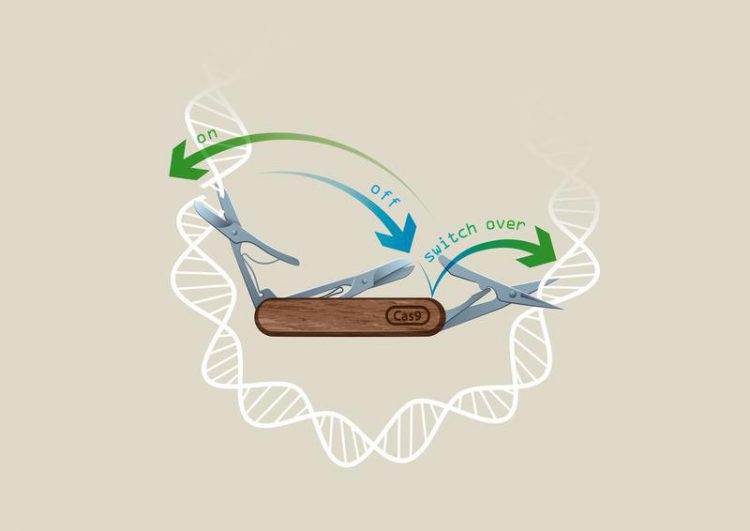Harnessing the power of CRISPR in space and time

CRISPR-Switch technology. ©IMBA/Kaminski Grafik
CRISPR/Cas9 technology is based on a modified version of a bacterial defense system against bacteriophages. One of the landmark discoveries for this technique in fact was laid in Vienna and published in 2012 in a study co-authored by Emmanuelle Charpentier and VBC PhD student, Krzysztof Chylinski. Due to its power to also edit mammalian genomes, CRISPR/Cas9 has rapidly established itself as the most employed gene editing method in laboratories across the world with huge potential to find its way to the clinics to cure rare disease. Just a week ago, the first success in the treatment of sickle cell anemia was announced.
To control the power of genome editing, several groups have worked on systems to control editing activity. Scientists from the lab of Ulrich Elling at IMBA were now able to gain unprecedented control over sgRNA activity, in a system termed “CRISPR-Switch”. The results are published in the renowned journal Nature Communications.
The CRISPR-Switch system radically amplifies the application potential of CRISPR-based gene editing, as it can be rapidly switched on without any detectable leakiness. It also circumvents possible immune responses in vivo, as it is not based on the modulation of Cas9 expression as previous methods were.
In CRISPR-Switch from the Elling lab, gene editing is achieved by modulating sgRNA expression, using a system based on Cre-Lox and Flp-FRT recombinases. These are site-specific recombination systems, which allow a precise location and timing of gene expression. Cre and Flp are known for their high recombination efficiency in different cell types, as well as their precision.
By using the novel CRISPR-Switch method, scientists are able to target genes with superior specificity, and, due to the use of recombinases, a gene can be knocked out in one chosen cell type precisely. As additional level of control, multiple genes can now be knocked out in any desirable order. This allows for unprecedented versatility in the CRISPR technique, as the exact timing of gene activation can be studied in different pathologies both in vivo and in vitro. Together with IMBA Alumnus Daniel Schramek from the Lunenfeld-Tanenbaum Research Institute in Toronto, the authors studied the order of mutagenic events that would result in glioma formation in mouse models. The CRISPR-Switch method is versatile and can be applied to different tumor types thus detecting the exact sequence of genes needed to induce tumor formation. What bears incredible potential is that with this technique, not only tumor initiation can be studied, but also the very challenging topic of tumor maintenance can be tackled.
The shared-first author of the study, Maria Hubmann, explains: “Our in vivo studies in mice confirmed that an explicit order of gene knockout was necessary for tumor formation. We looked at two specific genes, NF1 and TRP53, which are known to have a strong link to glioblastoma. Only when we knocked out TRP53 before NF1, and not vice versa, the mice developed gliomas”.
“CRISPR-Switch allows us to control gene editing in space and time, while ensuring an incredibly rapid on/off switch and with minimal unspecific effects. I am excited about the future applications of our method, as I am sure labs all over the world will soon find its benefits,” explains Krzysztof Chylinski, shared-first author from the Vienna BioCenter Core Facilities.
The CRISPR-Switch technology is also available as a partnering opportunity. IMBA is actively seeking for licensing partners with business interests in relevant areas of application, i.e. screening, mutation analysis, safer genome editing, multiplexing and/or somatic gene therapy.
Original publication:
Krzysztof Chylinski and Maria Hubmann, Ruth E. Hanna, Connor Yanchus, Georg Michlits, Esther C. H. Uijttewaal, John Doench, Daniel Schramek, Ulrich Elling
“CRISPR-Switch regulates sgRNA activity by Cre recombination for sequential editing of two loci”, Nature Communications, DOI 10.1038/s41467-019-13403-y
About IMBA
IMBA – Institute of Molecular Biotechnology – is one of the leading biomedical research institutes in Europe focusing on cutting-edge stem cell technologies, functional genomics, and RNA biology. IMBA is located at the Vienna BioCenter, the vibrant cluster of universities, research institutes and biotech companies in Austria. IMBA is a subsidiary of the Austrian Academy of Sciences, the leading national sponsor of non-university academic research. The stem cell and organoid research at IMBA is being funded by the Austrian Federal Ministry of Science and the City of Vienna. www.imba.oeaw.ac.at
About the Vienna BioCenter
Vienna BioCenter is a leading life sciences location in Europe, offering a unique combination of research, education and companies on a single campus: 1,800 employees, 1,500 students, 96 research groups, and 25 biotech companies. Scientists from 70 countries create a highly dynamic environment of international standards.
www.viennabiocenter.org
Media Contact
More Information:
http://www.imba.oeaw.ac.atAll latest news from the category: Life Sciences and Chemistry
Articles and reports from the Life Sciences and chemistry area deal with applied and basic research into modern biology, chemistry and human medicine.
Valuable information can be found on a range of life sciences fields including bacteriology, biochemistry, bionics, bioinformatics, biophysics, biotechnology, genetics, geobotany, human biology, marine biology, microbiology, molecular biology, cellular biology, zoology, bioinorganic chemistry, microchemistry and environmental chemistry.
Newest articles

NASA: Mystery of life’s handedness deepens
The mystery of why life uses molecules with specific orientations has deepened with a NASA-funded discovery that RNA — a key molecule thought to have potentially held the instructions for…

What are the effects of historic lithium mining on water quality?
Study reveals low levels of common contaminants but high levels of other elements in waters associated with an abandoned lithium mine. Lithium ore and mining waste from a historic lithium…

Quantum-inspired design boosts efficiency of heat-to-electricity conversion
Rice engineers take unconventional route to improving thermophotovoltaic systems. Researchers at Rice University have found a new way to improve a key element of thermophotovoltaic (TPV) systems, which convert heat…



